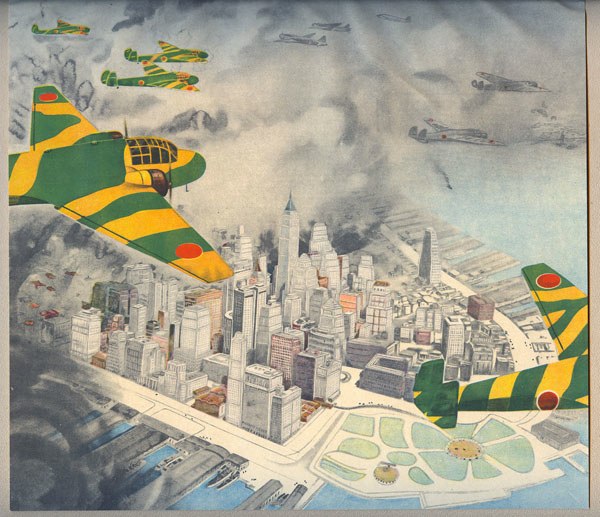Ki-2 "Louise" Models Ki-4
Type 94 Models
Ki-4
Type 94 Models Ki-5
Models
Ki-5
Models Ki-6
Models
Ki-6
Models Ki-9 Type 95 Models Ki-9 Type 95 Models Ki-10
"Perry" Models Ki-10
"Perry" Models Ki-12
Models
Ki-12
Models Ki-15 BABS Models
Ki-15 BABS Models Ki-16
Models
Ki-16
Models Ki-17 Models
Ki-17 Models Ki-21
"Sally" Models
Ki-21
"Sally" Models Ki-23
Models Ki-23
Models Ki-27 "Nate" Models
Ki-27 "Nate" Models Ki-28
"Bob" Models Ki-28
"Bob" Models Ki-30 "Ann" Models
Ki-30 "Ann" Models Ki-32 "Mary" Models
Ki-32 "Mary" Models Ki-34 "Thora" Models
Ki-34 "Thora" Models Ki-36 Models
Ki-36 Models Ki-41
Models Ki-41
Models Ki-43 Hayabusa "Oscar" Models
Ki-43 Hayabusa "Oscar" Models Ki-44 Shoki "Tojo" Models Ki-44 Shoki "Tojo" Models Ki-45 Kai "Toryu" (NICK) Models Ki-45 Kai "Toryu" (NICK) Models Ki-46 Models
Ki-46 Models Ki-48
LILY light Bomber Models Ki-48
LILY light Bomber Models Ki-49 Donryu
Type 100 Twin Engine "Helen" Models
Ki-49 Donryu
Type 100 Twin Engine "Helen" Models Ki-51 Models
Ki-51 Models Ki-54
"Hickory" Models
Ki-54
"Hickory" Models Ki-55
"Ida" Trainer Models
Ki-55
"Ida" Trainer Models KI-56 "THALIA" Models
KI-56 "THALIA" Models Mitsubishi Ki-57 Models
Mitsubishi Ki-57 Models Ki-60 Models
Ki-60 Models Ki-61 Models
Ki-61 Models Ki-64 "Rob" Models
Ki-64 "Rob" Models Ki-66
Models
Ki-66
Models Ki-67 Yasukuni
"Peggy" Torpedo Bomber Models
Ki-67 Yasukuni
"Peggy" Torpedo Bomber Models KI-76
"STELLA" Models
KI-76
"STELLA" Models Ki-77 Models
Ki-77 Models Ki-78
Models Ki-78
Models Ki-79b Kamikaze Plane Model
Ki-79b Kamikaze Plane Model KI-83 RIKUGUN Models KI-83 RIKUGUN Models Ki-84 Hayate "Frank" Models
Ki-84 Hayate "Frank" Models Ki-86 "Cypress" Models
Ki-86 "Cypress" Models KI-87 Fighter Models
KI-87 Fighter Models Ki-91
Models
Ki-91
Models Ki-94 Models Ki-94 Models Ki-100-I KOH "TONY" Models
Ki-100-I KOH "TONY" Models KI-102
"RANDY" Models KI-102
"RANDY" Models Ki-106 Models
Ki-106 Models
|
|
|
|
Acoustic and Electric Guitars
Microscopes
Cheap Travel Deals
US Navy Ships at Pearl Harbor
World War 2 Planes at Pearl Harbor
Pearl Harbor DVD Movie and Videos
Pearl Harbor Books
WW2 Japanese Airplanes Attack Pearl Harbor
Japanese
Airplanes
Japanese Aviation Art
MitsubishiKI-30 "Ann" Models
Mitsubishi A5M2 Models
Mitsubishi A5M4 Models
Mitsubishi A5M5 Models
Mitsubishi A6M2 Models
Mitsubishi A6M3 Models
Mitsubishi A6M4 Models
Mitsubishi A6M5 "Zeke" Models
Mitsubishi A6M6 Models
Mitsubishi A6M7 Models
Mitsubishi A7M1 Models
Mitsubishi A7M2 Models
Mitsubishi F-1 Jet Fighter Models ;
;
Mitsubishi F-2A Jet Fighter Models
Mitsubishi G4M1 "Betty" Bomber Models
Mitsubishi J2M3
"Jack" Models
Mitsubishi
Ki-46 Models
Mitsubishi Ki-51 Models
Mitsubishi Ki-61 Models
MitsubishiT-2 Jet Fighter Models
Japanese Baka Bomb Models
Nakajima A2N1
Type 90 Models
Nakajima A6M2 Rufe Seaplane Models
NAKAJIMA
B5M2 Type 97 "Kate" Models 
Nakajima B5N1 Models
Nakajima B5N2 Models
Nakajima B6N2 TENZAM "Jill" Models
Nakajima C6N1
Saiun Models
Nakajima C6N2 Models
Nakajima E8N
"Dave" Models
Nakajima G8N1 Rita
4 Engine Bomber Models
Nakajima J1N1 Models
Nakajima J1N1 Gekko Models
Nakajima J9N
KIKKI WW2 Jet
NAKAJIMA Ki-4
Type 94 Models
NAKAJIMA Ki-27 "Nate" Models
Nakajima Ki-34
Thora Models
NAKAJIMA Ki-43 Hayabusa "Oscar" Models
NAKAJIMA Ki-44 Shoki "Tojo" Models
NAKAJIMA Ki-49 Donryu
Type 100 Twin Engine "Helen" Models
NAKAJIMA Ki-84 Hayate "Frank" Models
NakajimaType L2D2 Kinsei Models
Nakajima NAF-2 Models
Nakajima Ginga Models
NAKAJIMA Type 11 Gekko Twin Engine Models
Nakajima Type 91 Models
Tachikawa Ki-9 Type 95 Models
Tachikawa Ki-17 Models
Tachikawa Ki-36 Models
Tachikawa Ki-54
"Hickory" Models
Tachikawa Ki-55
"Ida" Trainer Models
Tachikawa Ki-77 Models
Tachikawa KI-94 Models
Tachikawa Ki-106 Models
Tachikawa KKY-1 Models
Tachikawa KKY-2 Models
Tachikawa KS Models
Guitars for Sale
iPhones, Cell Phones, Mobile Phones, GPS
Apple iPhones
Boost Mobile Phones
Smart Phone GPS
Android 4G
Android 3G
Android Dual
Android Unlocked
LG Optimus
iPhone 5
Samsung Galaxy
Virgin Mobile
HTC Onemax
HTC Desire
128 GB Cell Phones
64 GB Cell Phones
32 GB Cell Phones
16 GB Cell Phones
8 GB Cell Phones
Quad Core Cell Phones
Dual Core Cell Phones
GSM Cell Phones
Motorola Cell Phones
ZTE Smartphones
Smartphones
Unlocked AT&T
Unlocked T-Mobile
Unlocked Straight Talk Mobile
Unlocked Android
|
|
Nakajima Nishiki-suisen "Rufe" 1/48 Kit
Based on the Mitsubishi A6M Zero, Nakajima's A6M2-N (Allied reporting name "Rufe")
was a single-seat interceptor/fighter-bomber that served with the Imperial
Japanese Navy from 1942 through the end of World War II. The plastic kits of these
versatile floatplanes usually include detail features like finely recessed panel lines, a detailed cockpit,
an intricate 14-cylinder Nakajima Sakae radial engine, 20mm and 7.7mm machine
guns.
Mitsubishi A6M3 Zero 1/27 Balsa Kit
Nakajima Ki-43-II Late Version Hayabusa 1/48 Kit. Introduced in 1939, the
Nakajima Ki-43 Hayabusa (Peregrine Falcon) was the most widely used Imperial
Japanese Army Air Force fighter of World War II.
A replica of a late variant of the Ki-43-II "Oscar," this 1/48 scale, plastic
Hasegawa kit features textured surfaces; a detailed cockpit with an instrument
panel and a glazed canopy; intricate landing gear; bombs and drop tanks; a
choice of Captain Yukinchi Kitakoga's 2nd Squadron, 54th Flight Regiment, or
Captain Hisashi Koshiishi's 3rd Squadron, 54th Flight Regiment, markings; and
more. 8" wingspan; 82 parts, skill level 3. |
Mitsubishi A6M2b Zero 1/32 Kit
Pearl Harbor
an A6M2b Zero Model 21 employed in the December 7, 1941, Japanese
attack on Pearl Harbor, this amazingly detailed, 1/32 scale, plastic kit
features engraved panel lines and simulated rivets, a fully outfitted cockpit
with photo-etched metal seatbelts and a glazed canopy, a realistic Nakajima
Sakae Type 12 radial engine, optional-position wingtips, a metal pitot tube,
movable flight control surfaces and retractable metal landing gear, a choice of
seven markings for planes from the Pearl Harbor attack, standing and seated
pilot figures, wheel chocks and access steps, and a display stand. 14"
wingspan; assembly required.
|
|
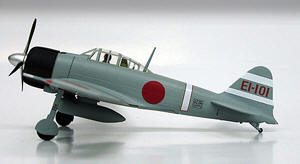
A6M2 Zero 1/72 Die Cast Model
"Shokaku Group," 1st KK, 5th KS, Pearl Harbor
On November 26, 1941, six Imperial Japanese Navy aircraft carriers - Akagi, Kaga,
Soryu, Hiryu, Shokaku and Zuikaku - departed northern Japan for a position
northwest of Hawaii, from which they would launch the infamous, December 7
attack on Pearl Harbor.
the Mitsubishi A6M2 Zero Model 21 flown off the Shokaku by 8-victory
ace Lt. Cmdr. Tadashi Kaneko during the first wave attack on Pearl Harbor, this
limited edition, 1/72 scale, die cast Witty Wings model features finely textured
surfaces, a detailed cockpit with a hand-painted pilot figure and a glazed
"birdcage" canopy, 20mm cannon ports on the wings' leading edge, a centerline
fuel tank, a rotating propeller, extended landing gear, and authentic 1st Koku
Kantai, 5th Koku Sentai, markings. 6" wingspan. |
|
A6M5 Zero 1/48 Die Cast Model
Part of the Smithsonian Museum Replica Series, this value d, 1/48 scale,
die cast model of an A6M5 Zero Model 52 - which, considered to be the most
effective variant, was developed to face the powerful Hellcat and Corsair -
features textured surfaces, a glazed canopy, a rotating propeller, authentic
Imperial Japanese Navy Air Service markings, a Zero collector's card, and more.
9" wingspan; includes a display stand. |
|
A6M5 Zero 1/72 Die Cast Model
721st Naval Flying Group
This 1/72 scale die cast model features textured surfaces, a detailed cockpit
with a "birdcage" canopy and a pilot figure, realistic armament and a drop tank,
a rotating propeller, extended landing gear, authentic markings, and more. 6"
wingspan; includes a display stand.
|
|
A6M5 Zero 1/72 Die Cast Model
Saipan Island
a Mitsubishi A6M5 Type 52 Zero captured by the U.S. Marines on
Saipan Island in June, 1944, this 1/72 scale, die cast Witty Sky Guardians model
features textured surfaces; a detailed cockpit with a "birdcage" canopy and a
pilot figure; machine gun ports on the engine cowling; an external fuel tank, a
rotating propeller, and extended landing gear; authentic markings; and more. 6"
wingspan; includes a display stand.
|
|
A6M5 Zero 1/72 Die Cast Model
261st Naval Air Corps, Saipan Island
This 1/72 scale die cast model features textured surfaces, a detailed cockpit
with a "birdcage" canopy and a pilot figure, realistic armament and a drop tank,
a rotating propeller, extended landing gear, authentic markings, and more. 6"
wingspan; includes a display stand. |
|
A6M5c Type 52 Zero 1/32 Kit
The Type 52 "Zero" was an upgraded variant of the primary Japanese fighter with
a faster top speed and improved armor and armament. Plastic kit features raised
panel lines and simulated rivets, incredibly detailed 41-part Sakae engine with
separate cylinders and exhaust stacks, authentic-look cockpit with pilot figure,
optional position canopy and wing flaps, external stores, choice of markings and
97 pieces. 13" wingspan; assembly required. |
|
A6M5 Zero 1/72 Die Cast Model
Rabul Flying Group
This 1/72 scale die cast model features textured surfaces, a detailed cockpit
with a "birdcage" canopy and a pilot figure, realistic armament and a drop tank,
a rotating propeller, extended landing gear, authentic markings, and more. 6"
wingspan; includes a display stand. |
|
A6M5 Zero 1/72 Die Cast Model
261st Fly Group
This 1/72 scale die cast model features textured surfaces, a detailed cockpit
with a "birdcage" canopy and a pilot figure, realistic armament and a drop tank,
a rotating propeller, extended landing gear, authentic markings, and more. 6"
wingspan; includes a display stand. |
|
A6M5 Zero 1/72 Die Cast Model
261st Naval Flying Group
an extant Zero - assigned to the air defense of the islands of
Saipan, Tinian, Rota and Palau - that was captured when U.S. Marines swarmed
Saipan's Asilito Airfield on June 18, 1944, this 1/72 scale die cast model
features engraved panel lines, a detailed cockpit with a pilot figure and a
"birdcage" canopy, realistic armament and a drop tank, a rotating propeller,
extended landing gear, authentic 261st Japanese Naval Air Corps markings, and
more. 5" wingspan; includes a display stand.
|
|
A6M2b Zero 1/97 Die Cast Model
the Imperial Japanese Navy Type 21, carrier-based, single-seat A6M2b
Zero flown by 64-victory ace Saburo Sakai, who, along with Hiroyoshi Nishizawa
(113 victories) and Toshio Ohta (34), formed the elite Tainan Ku's famous "Ace
Trio," this 1/97 scale, die cast Model Power model features a framed canopy with
clear plastic windows, a centerline fuel tank, authentic Tainan Kokutai
markings, and more. 4" wingspan; includes a display stand.
|
Mitsubishi
A6M5c Zero 1/48 Scale Model Kit
Plastic Model Kit
Introduced early in World War II, the Mitsubishi A6M5 "Zero" was widely
considered the most capable carrier-based fighter in the world, averaging a kill
ratio of 12 to 1. In 1942, however, Allied technology caught up to the Zero and
the aerial battlefield was leveled.
A replica of an A6M5c variant - heavily armed with three 13.2 mm machine guns
and two 20 mm Type 99-II guns - of the Zero, this 1/48 scale, plastic kit
features engraved panel lines; a detailed cockpit with a glazed,
optional-position canopy; a three-part Sakae engine with a rotating propeller;
wing-mounted rockets and bombs and a centerline drop tank; optional-position
landing gear; a choice of authentic markings for seven aircraft; and more. You
even get standing and seated pilot figures and six waving ground crew figures!
9" wingspan; 60 parts, assembly required. |
Mitsubishi
Zero Balsa Wood Kit
Balsa Wood Model Kit
This 1/16 scale balsa kit has
a wingspan of 27¾" and includes light plastic detail
parts, a bubble canopy, light tissue and a complete set of decals. For
display, rubber-powered or gas-powered flight. Assembly required. |
Mitsubishi Zero Balsa Model Kit
Balsa Wood Model Kit
Flying Airplane, Rubber Power
Build your own replica of this famed Japanese WWII fighter. 1/23
scale kit of balsa wood and tissue paper has a 20" wingspan when completed.
For display or rubber-powered flight; assembly required. |
A6M3
Zero 1/48 Scale Model Kit
Plastic Model Kit
Detailed plastic kit of the Imperial Japanese Navy's best-known
fighter from the late stages of the Pacific War features recessed panel
lines, realistic Sakae radial engine and intricate landing gear.
Includes pilot and ground crew figures, drop tank, weapons, choice of markings
and 60 pieces. 9" wingspan; assembly required. |
A6M5c
Type 52 Zero 1/32 Model Kit
Plastic Model Kit
The Type 52 "Zero" was an upgraded variant of the primary Japanese
fighter with a faster top speed and improved armor and armament.
Plastic kit features raised panel lines and simulated rivets, incredibly
detailed 41-part Sakae engine with separate cylinders and exhaust stacks,
authentic-look cockpit with pilot figure, optional position canopy
and wing flaps, external stores, choice of markings and 97 pieces. 13"
wingspan; assembly required. |
Nakajima
Rufe Balsa Wood Model Kit
Balsa Wood Model Kit
The Japanese Navy used the Nakajima A6M2-N seaplane, an adaptation
of the Mitsubishi Zero-fighter plane, throughout the war. It was named
the "Rufe" by the Allies and served in both the North and South Pacific
theaters from the Aleutian Islands to the Solomon's. This 1/32 scale kit
is easy to build and contains die-cut balsa parts, plastic cowls
and canopies, decals, plastic prop, wheels, tissue and a 24-page
model building booklet. 16?" wingspan, assembly required. |
Aichi D3A1 "Val" 1/102 Scale
Pre Built Die Cast Model Fighter Airplane
an Aichi dive bomber that flew from the
Imperial Japanese Navy carrier Soryu during the December 7, 1941, attack on
Pearl Harbor, this 1/102 scale die cast model features textured surfaces, a
clear cockpit canopy, a 250kg bomb under the fuselage, a rotating propeller,
authentic markings, and more. 5" wingspan; includes a display stand. |
Aichi M6A1 Seiran 1/72 Scale
Plastic Model Kit
Developed by the Japanese Navy to fly off I-400 and
I-401 submarines, the Aichi M6A1 Seiran had floats for landing next to its
sub and folding wings for compact storage. This 1/72 scale plastic kit of
the Seiran features finely recessed panel lines; a highly detailed,
multi-part cockpit; a beaching dolly for display of the completed kit; a
choice of markings and more. 6" wingspan; approximately 50 parts, assembly
required. |
Aichi M6A1 Seiran 1/48 Scale
Plastic Model Airplane Kit
Developed by the Japanese Navy to fly off I-400 and
I-401 submarines, the Aichi M6A1 Seiran had floats for landing next to its
sub and folding wings for compact storage. This 1/48 scale plastic kit of
the Seiran includes a detailed cockpit, a beaching dolly for display of the
completed kit, a choice of markings and more. 8" long with a 10" wingspan;
approximately 75 parts, assembly required. |
|
A6M2 Zero 1/48 Die Cast Kit
Lt. Yukio Seki, Battle of Leyte Gulf, October 25, 1944
During the Battle of Leyte Gulf on October 25, 1944, Lt. Yukio Seki led the
second official kamikaze attack of World War II. Taking off from Luzon Island in
the Philippines, Seki's unit of five bomb-equipped Mitsubishi A6M2 Zero fighters
crash-dived into four Taffy 3 escort carriers, becoming the first kamikazes to
sink an enemy ship, the USS St. Lo (CVE-63).
the A6M2 flown by Seki on that kamikaze mission, this
easy-to-assemble, 1/48 scale, metal and plastic kit features a detailed cockpit
with a sliding canopy, a metal propeller and hub unit that replicates the
compression stroke of a reciprocating engine, a fuselage-mounted 250kg bomb,
optional-position landing gear with rolling wheels, and authentic Shikishima
unit markings. 9" wingspan; minor assembly required.
|
|
A6M2 Zero 1/144 Die Cast Model
IJN Aircraft Carrier Zuikaku, Pearl Harbor, December, 1941
On November 26, 1941, six Imperial Japanese Navy aircraft carriers - Akagi, Kaga,
Soryu, Hiryu, Shokaku and Zuikaku - departed northern Japan for a position
northwest of Hawaii, from which they would launch the infamous, December 7
attack on Pearl Harbor.
a Mitsubishi A6M2 Zero Model 21 that - flown off the Zuikaku by Lt.
Masao Sato - was part of the Carrier Division 5, Air Superiority Command, first
wave attack on Pearl Harbor, this limited edition, 1/144 scale, die cast X Plus
Heavy Metal model features engraved panel lines, a well-equipped cockpit with a
glazed "birdcage" canopy, a centerline fuel tank, a rotating metal propeller,
extended landing gear, and authentic 1st Koku Kantai, 5th Koku Sentai, markings.
3" wingspan; includes a carrier deck display base with a nameplate. |
|
A6M2 Zero 1/144 Die Cast Model
IJN Aircraft Carrier Kaga, Pearl Harbor, December, 1941
On November 26, 1941, six Imperial Japanese Navy aircraft carriers - Akagi, Kaga,
Soryu, Hiryu, Shokaku and Zuikaku - departed northern Japan for a position
northwest of Hawaii, from which they would launch the infamous, December 7
attack on Pearl Harbor.
a Mitsubishi A6M2 Zero Model 21 that - flown off the Kaga by
13-victory ace Petty Officer 1st Class Akira Yamamoto - was part of the Carrier
Division 1, Air Superiority Command, first wave attack on Pearl Harbor, this
limited edition, 1/144 scale, die cast X Plus Heavy Metal model features
engraved panel lines, a well-equipped cockpit with a glazed "birdcage" canopy, a
centerline fuel tank, a rotating metal propeller, extended landing gear, and
authentic 1st Koku Kantai, 1st Koku Sentai, markings. 3" wingspan; includes a
carrier deck display base with a nameplate. |
|
A6M2 Zero 1/144 Die Cast Model
IJN Aircraft Carrier Hiryu, Pearl Harbor, December, 1941
On November 26, 1941, six Imperial Japanese Navy aircraft carriers - Akagi, Kaga,
Soryu, Hiryu, Shokaku and Zuikaku - departed northern Japan for a position
northwest of Hawaii, from which they would launch the infamous, December 7
attack on Pearl Harbor.
a Mitsubishi A6M2 Zero Model 21 that - flown off the Hiry? by Lt.
Kiokuma Okajima - was part of the Carrier Division 2, Air Superiority Command,
first wave attack on Pearl Harbor, this limited edition, 1/144 scale, die cast X
Plus Heavy Metal model features engraved panel lines, a well-equipped cockpit
with a glazed "birdcage" canopy, a centerline fuel tank, a rotating metal
propeller, extended landing gear, and authentic 1st Koku Kantai, 2nd Koku Sentai,
markings. 3" wingspan; includes a carrier deck display base with a nameplate. |
|
A6M2 Zero 1/144 Die Cast Model
IJN Aircraft Carrier Shokaku, Pearl Harbor, December, 1941
On November 26, 1941, six Imperial Japanese Navy aircraft carriers - Akagi, Kaga,
Soryu, Hiryu, Shokaku and Zuikaku - departed northern Japan for a position
northwest of Hawaii, from which they would launch the infamous, December 7
attack on Pearl Harbor.
a Mitsubishi A6M2 Zero Model 21 that - flown off the Sh?kaku by
8-victory ace Lt. (jg) Masao Iizuka - was one of the Carrier Division 5, Air
Superiority Command, aircraft that flew combat air patrol (CAP) over the
Japanese fleet during the attack on Pearl Harbor, this limited edition, 1/144
scale, die cast X Plus Heavy Metal model features engraved panel lines, a
well-equipped cockpit with a glazed "birdcage" canopy, a centerline fuel tank, a
rotating metal propeller, extended landing gear, and authentic 1st Koku Kantai,
5th Koku Sentai, markings. 3" wingspan; includes a carrier deck display base
with a nameplate.
|
A6M2 Zero 1/144 Die Cast Model
IJN Aircraft Carrier Soryu, Pearl Harbor, December, 1941
On November 26, 1941, six Imperial Japanese Navy aircraft carriers - Akagi, Kaga,
Soryu, Hiryu, Shokaku and Zuikaku - departed northern Japan for a position
northwest of Hawaii, from which they would launch the infamous, December 7
attack on Pearl Harbor.
a Mitsubishi A6M2 Zero Model 21 that - flown off the S?ry? by
7-victory ace Lt. Fusata Iida - was the lead aircraft during the Carrier
Division 2, Air Superiority Command, second wave attack on Pearl Harbor, this
limited edition, 1/144 scale, die cast X Plus Heavy Metal model features
engraved panel lines, a well-equipped cockpit with a glazed "birdcage" canopy, a
centerline fuel tank, a rotating metal propeller, extended landing gear,
authentic markings, and authentic 1st Koku Kantai, 2nd Koku Sentai, markings.
3" wingspan; includes a carrier deck display base with a nameplate.
|
|
A6M2 Zero 1/144 Die Cast Model
IJN Aircraft Carrier Akagi, Pearl Harbor, December, 1941
On November 26, 1941, six Imperial Japanese Navy aircraft carriers - Akagi, Kaga,
Soryu, Hiryu, Shokaku and Zuikaku - departed northern Japan for a position
northwest of Hawaii, from which they would launch the infamous, December 7
attack on Pearl Harbor.
the Mitsubishi A6M2 Zero Model 21 that - flown off the Akagi by Lt.
Saburo Shindo - led the Carrier Division 1, Air Superiority Command, second wave
attack on Pearl Harbor, this limited edition, 1/144 scale, die cast X Plus Heavy
Metal model features engraved panel lines, a well-equipped cockpit with a glazed
"birdcage" canopy, a centerline fuel tank, a rotating metal propeller, extended
landing gear, and authentic 1st Koku Kantai, 1st Koku Sentai, markings. 3"
wingspan; includes a carrier deck display base with a nameplate.
|
|
A6M Books |
Meatballs and Dead Birds
A Photo Gallery of Destroyed Japanese Aircraft in World War II
Gallagher. Snapped by the author, a communications officer with the Fifth Air
Force in the Pacific islands during the final days of World War II, these
stunning photographs cover all manner of downed Japanese aircraft, from the
infamous Zero fighter to the Betty bomber. Also includes specifications and
technical data for many of the types. 144 pages, 180 B&W photographs, 20
illustrations, 11"x 8", softcover.
|
Mitsubishi A6M Zero Fighter
Aero Detail Vol. 7
A close-up photographic tour of wonderfully restored examples of the famed
Japanese Zero from museums around the world. Over 300 photos, color plates,
detailed line drawings and technical drawings give you the closest look
possible. 87 pages, 10"x 10", softcover. |
Mitsubishi A6M-1/2-N Zero-Sen
in JAAF Service
Richard M. Bueschel This fighter - by far the most famous of all Japanese
aircraft - dominated the first six months of the aerial war in the Pacific, and
continued in service until the end of hostilities. The Zero - allied code-name
'Zeke' - was remarkable in being the first carrier fighter to outperform its
land-based equivalents. All variations and markings are featured here. 64 pgs.,
over 150 photos, 8"x 11", sfbd.
|
|
End of the Beginning -
Turtledove. "An exciting military thriller… another triumph." - Midwest Book
Review. In this alternate-history novel, the Japanese brutally occupy Hawaii
after their attack on Pearl Harbor while America marshals its military forces -
including a new kind of aircraft that can hold its own against the Zero - to
reclaim the islands. 440 pages, 6"x 9", hardcover.
|
Koga's Zero
Rearden. Compelling story of Japanese raids on the Aleutian Islands during WWII.
In those raids, a Japanese flyer crash-landed on Akutan Island and died in his
airplane. Important performance details were learned when the plane was rebuilt
and test flown. Also details the search for the pilot’s buried body after the
war. 114 pgs., Illustrated, 7"x 10", sfbd. |
Nakajima Ki-43 Hayabusa in JAAF Service
Richard M. Bueschel. The Ki-43, known to the Allies as Oscar, was the single
most numerous fighter operated by the Imperial Japanese Army. Comparable to the
A6M Zero-Sen, it was highly maneuverable but fragile and had lightweight
armament. Here, you'll see all variations and markings of the plane flown by the
majority of Japanese army aces. 64 pages, 100+ B&W photographs, 8"x11",
softcover.
|
Samurai!
Sakai. Originally published in 1957, this memoir - written by 64-victory ace
Saburo Sakai, who was Japan's greatest fighter pilot to survive World War II -
is a valuable eyewitness account of some of the most famous air battles in
history and a moving, personal story of a Samurai warrior who fought more than
200 dogfights and famously flew his crippled Zero nearly 600 miles to safety
while partially paralyzed and nearly blind from multiple wounds. 384 pages, B&W
photographs, 6"x 9", hardcover. |
Guests of the Emperor
The Secret History of Japan's Mukden POW Camp.
Goetz Holmes. This book recounts the horrific experiences of the more than 2,000
American POWs held during World War II at Mitsubishi's huge factory complex at
Mukden, Manchuria, where they were subjected to cold, starvation, beatings and
even biological experiments while forced to manufacture parts for Zero fighter
planes. 192 pages, 20 B&W photographs, 6"x 9", hardcover.
|
Seafire F.III vs. A6M Zero
Pacific Theater.
Nijboer. This lavishly illustrated book examines two vastly different fighters
that faced each other high above the Japanese homeland in the last dogfight of
World War II: the Seafire F.III - the first true carrier adaptation of the
Supermarine Spitfire design - and the Japanese A6M Zero. You'll study key
elements such as airframes, engines, armament and flying characteristics to
learn the planes' strengths and weaknesses; view fascinating cockpit
illustrations; and more. 80 pages, B&W photographs and color illustrations, 7"x
9", softcover.
|
Setting Suns
Captured & Wrecked Japanese Aircraft in WWII.
Laemlein. Filled with rare archival images accompanied by detailed captions,
this photo-history examines Imperial Japanese Army and Navy combat aircraft that
were captured or wrecked in the Pacific and China-Burma-India Theaters of World
War II.
You'll view the famous "Alaska Zero," a G4M1 Betty floating on the surface of
Iron Bottom Sound, a Ki-63 Tony captured at Cape Gloucester, decoy aircraft, the
rare MXY7 Ohka "Baka bomb" manned anti-shipping rocket, and more. 145 pages, B&W
photographs, 10"x 8", softcover. |
Setting Suns II
Captured & Wrecked Japanese Aircraft in WWII.
Laemlein. Filled with rare archival images accompanied by detailed captions,
this photo-history examines Imperial Japanese Army and Navy combat aircraft that
were captured or wrecked in the Pacific and China-Burma-India Theaters of World
War II.
You'll view types such as the A6M Zero, Nakajima Ki-84 Frank, Ki-43 Oscar, decoy
aircraft, and many others, as well as 20mm cannon and anti-aircraft guns. 127
pages, B&W photographs, 10"x 8", softcover. |
The Setting of the Rising Sun
Japanese Military Aviation 1877-1945. Treadwell. This heavily illustrated book
examines the development of Japanese military aviation, from the mid-Victorian
era, when Japan was just beginning to open up to the rest of the world, through
the end of World War II. You'll view kites, balloons, and gliders; famous
fighters and dive-bombers such as Zeros, Kates and Vals; flying bombs and the
Japanese version of the German Me 163 rocket fighter; and more. 224 pages, 220
B&W photographs and illustrations, 7"x 10", softcover.
|
Inside History-Making Aircraft of World War II
In the Cockpit II
Connor & Moore. This lavishly illustrated volume presents stunning close-up
photographs of the cockpits and crew stations of 34 legendary World War II
aircraft in the Smithsonian National Air and Space Museum's impressive
collection. You'll view the interiors of the American P-51D Mustang, P-39Q
Airacobra, B-17 Flying Fortress, B-29 Superfortress "Enola Gay," SBD-6
Dauntless, and Boeing Kaydet trainer; the British Spitfire; the Soviet Il-2
Sturmovik; the Japanese A6M5 Zero; the German Fw 190 and Me 262A jet; and many
others. 144 pages, 120+ color and B&W photographs, 8"x 10", hardcover. |
Reaper Leader
The Life of Jimmy Flatley
Ewing. Although Jimmy Flatley had much to do with the U.S. victory over Japan,
few know of his naval heroics - formidable fighter pilot, inspiring leader, and
gifted operational planner. This biography reveals his persistence that proved
the F4F Wildcat superior to the Zero, that sweepingly improved naval aviation
safety and that, in the post-war years, continually challenged the naval
establishment from within. 384 pages, 26 B&W photographs, 6"x 9", hardcover.
|
The Last Flight of Bomber 31
Harrowing Tales of American and Japanese Pilots Who Fought World War II's Arctic
Air Campaign. Wetterhahn. Combining research with interviews of combatants from
both sides, the author recounts the air war above the Bering Sea, where American
pilots flew nine-hour missions in subzero temperatures to bomb Japanese
installations in the Kuril Islands. You'll also examine the crash sites of two
planes found in Russia and learn of their crews' harrowing experiences. 364
pages, 8 pages of B&W photographs, 6"x 9", hardcover.
|
|
Dogfight
The Greatest Air Duels of World War II.
Holmes, ed. Filled with rare photographs and meticulous digital reconstructions,
firsthand accounts, information on flight characteristics and fighting
capabilities, and biographies of famous aces, this volume examines clashes
between some of the greatest fighter aircraft of World War II. You'll read about
the Spitfire vs. Bf 109, P-51 Mustang vs. Fw 190, P-40 Warhawk vs. Ki-43 Oscar,
P-47 Thunderbolt vs. Bf 109G, and Seafire vs. Zero. 352 pages, B&W photographs
and color illustrations, 7"x 10", hardcover.
|
|
Air Battles of World War II - DVD
The War File
This program covering the aerial warfare of World War II features dramatic
footage of dogfights over England, the F4U Corsair and F6F Hellcat versus the
Japanese A6M Zero, the 617 Squadron "Dambusters" Operation Chastise bombing
raids, B-24s on the Ploesti mission, the battle for the Island of Malta, the air
war over the battlefields of the Kursk Salient between Russian and German aces,
and more. B&W, Dolby Digital, 1 hour.
|
|
Babo - DVD
Japanese Airfield
Wrecked military aircraft remained undisturbed for decades at Indonesia's Babo
Airfield, a remote air base used by the Dutch, Australian and Japanese forces in
World War II. Now, this thrilling 1991 adventure to the remote air base
documents the airfield, its wartime history, and the recovery of an A6M3 Zero, a
G4M1 Betty and a D4Y1 Judy. Color, Dolby Digital 2.0, 1 hour.
|
|
Captured Zero Fighters - DVD
This program presents fascinating footage of captured Mitsubishi A6M Zero Model
21 and Model 32 fighters being tested and flown by the U.S. Navy during World
War II. As a bonus, you'll also view the air exercises of a captured German Fw
190. B&W, 46 minutes.
|
Secret Japanese Aircraft of WWII - DVD
History Undercover
This fascinating program follows the development of the Japanese aircraft
industry from its famous A6M Zero to the top-secret programs under development
at war's end. You'll discover how close Japan was to unveiling rocket and
jet-powered planes based on German designs and, though they were too late to
help in the war effort, how those projects proved their worth, helping to launch
the post-war Japanese rocket program. 50 minutes.
|
Empire of the Sun (DVD Version Snap Case)e/irB00003CX9U
Steven Spielberg's
Video
Movie Suggestion by Art Griggs
A young British boy's noble spirit allows him to survive the hardships of a
Japanese prison camp in China during World War II.
amazone.com essential video
Roundly dismissed as one of Steven Spielberg's
least successful efforts, this very underrated film poignantly follows
the World War II adventures of young Jim (a brilliant Christian Bale),
caught in the throes of the fall of China. What if you once had everything
and lost it all in an afternoon? What if you were only 12? Bale's
transformation, from pampered British ruling-class child to an imprisoned,
desperate, nearly feral boy, is nothing short of stunning. Also stunning
are exceptional sets, cinematography, and music (the last courtesy of John
Williams) that enhance author J.G. Ballard's and screenwriter Tom Stoppard's
depiction of another, less familiar casualty of war.
Epic "coming of age" war drama from director Steven Spielberg follows a
young British boy's harrowing experiences in 1940s Shanghai. Separated from his
family during the Japanese invasion and thrown into a prison camp, the boy
develops a friendship with a captured American. Christian Bale, John Malkovich,
Miranda Richardson star. 152 min. Widescreen (Enhanced); Soundtracks: English
Dolby Digital 5.1, Dolby Digital Surround, French Dolby Digital Surround;
Subtitles: English, Chinese, French, Korean, Japanese, Portuguese, Spanish,
Thai; "making of" documentary; theatrical trailer; scene access; interactive
menus.
# Actors: Christian Bale, John Malkovich, Miranda
Richardson, Nigel Havers, Joe Pantoliano
# Directors: Steven Spielberg
# Writers: J.G. Ballard, Menno Meyjes, Tom Stoppard
# Producers: Chris Kenny, Frank Marshall, Kathleen Kennedy, Robert Shapiro
# Format: Closed-captioned, Color, Dolby, DVD, Subtitled, Widescreen, NTSC
# Language: English, French
# Subtitles: Chinese, English, French, Japanese, Korean, Portuguese, Spanish,
Taiwanese Chinese
# Region: Region 1 (U.S. and Canada only. Read more about DVD formats.)
# Aspect Ratio: 1.85:1
# Number of discs: 1
# Rated: PG (Parental Guidance Suggested)
# Studio: Warner Home Video
# DVD Release Date: November 6, 2001
# Run Time: 152 minutes
# Average Customer Review: 4.5 out of 5 stars See all reviews (272 customer
reviews)
# ASIN: B00003CX9U |
Mitzubishi Zero Audio CD
Hear the sounds of the only flying Nakajima Sakae 21-powered, Mitsubishi A6M5-52
"Zero" in the world! You're in the cockpit of this formidable WWII Japanese
fighter for start-ups, run-ups, take-offs and landings. You'll thrill to
high-speed aerobatics directly overhead. And in the adversary section of this
CD, you'll hear the sounds of the P-38, the P-40, the P-51, the F4U Corsair and
many more. It's the sounds of the Pacific on your stereo!
|
Living Warbirds - DVD
Steel Warriors.
This program puts you on the tarmac to see, hear and feel the fierce power of
magnificent World War II warbirds, including the P-38 Lightning, P-40N Warhawk,
P-51 Mustang, B-29 Superfortress, F4U Corsair, F4F Wildcat, T-6 Texan, SBD-5
Dauntless, A6M Zero, and many more! You'll hear the roar of the engines starting
(without narration or music to spoil your enjoyment), view close-ups of the
beautifully restored aircraft, and witness takeoffs, multiple flybys and
landings. Widescreen, Dolby, 1 hr. 43 min.
|
Showdown - DVD
Air Combat.
Featuring dramatic recreations with restored aircraft, this 2-DVD collection -
which includes all seven episodes of the series Showdown: Air Combat - puts you
inside some of the most thrilling aerial dogfights in history!
You'll view aircraft such as the P-38 Lightning, F4F Wildcat, F4U Corsair, P-47
Thunderbolt, P-51 Mustang, Me 109, Fw 190, A6M Zero, F-86 Sabre and MiG-15;
learn about each aircraft's strengths and weaknesses; analyze the groundbreaking
tactics employed in each confrontation; meet the extraordinary pilots who flew
the original missions; and more. 5 hours. |
|
Japanese Aviation Art Prints & Gifts
|
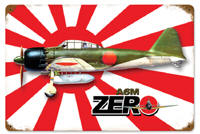 A6M Zero Metal Sign
Featuring an image of an A6M Zero set against a backdrop of the Japanese Navy's
"Rising Sun" flag, this metal sign is made of 24-gauge steel that is hand
distressed to create the look and feel of aged metal and paint. Measures 17"x
11" and includes mounting holes.
|
|
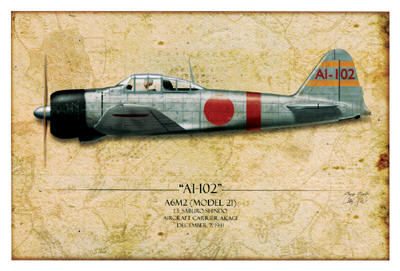
"AI-102:" A6M2 (Model 21)
Craig Tinder. Featuring a profile of "AI-102" - the A6M2 Zero that, flown off
the Akagi by Lt. Saburo Shindo, led the second wave attack on Pearl Harbor -
superimposed over a captured, hand-drawn Japanese map that outlines the position
of Battleship Row on that fateful day, this 19"x 13" print is signed by the
artist. |
|
Awakening the Giant
C.S. Bailey. Japanese Zeros from the Imperial Japanese Navy's flagship carrier
Akagi proceed to the opening strike at Pearl Harbor, December 7, 1941. 26"x 20"
limited edition print is signed and numbered by the artist.
|
Mitsubishi A6M5 Zero
Tony Weddel. The Zero's great speed, maneuverability, and long range initially
made it seem invincible, but by the war's end it was usually defeated by the
more numerous and powerful U.S. fighters. This scene portrays Japanese ace
Saburo Sakai on June 24 1944, as he attempts to evade a force of U.S. Hellcats
off of Iwo Jima. 23"x 19" print.
|
|
A Shot Across the Bow
Roy Grinnell. Moments after releasing a torpedo at the Japanese carrier Akagi at
the onset of the Battle of Midway, the B-26 Marauder Suzi-Q thunders down the
Japanese carrier's flight deck, nearly grazing the bridge in an attempt to
escape the gantlet of fire unleashed by the enemy surface fleet and swarming
Zero fighters. 30"x 20" limited edition, numbered print is signed by the artist
and James Muri, pilot of the Suzi-Q. |
|
Morning Thunder
Robert Taylor. During the second wave of attacks on Pearl Harbor, the "West
Virginia" is ablaze after six torpedo hits and two bomb strikes from the first
attack. With her bows already low in the water and decks awash, the crews ignore
the risks and push the Navy tug "Hoga" alongside to fight the fires and pick up
survivors. Overhead, Zeros swoop through the smoke aiming for the installations
on Ford Island. Signed and numbered by the artist and 8 Pearl Harbor survivors,
limited edition print measures 30"x 23". |
|
Ground Zero
Don Kloetzke. The A6M2 Zero piloted by Lt. Yasushi
Nikaido during the second wave of attacks on Pearl Harbor flies past the
burning wreckage of the USS Arizona. 24"x 18" limited edition print is
signed and numbered by the artist. |
The Guardians
Ross Buckland. Sacred Mount Fuji stands at attention while patrolling Zero
fighters protect the Japanese homeland during the summer of 1945. 30"x 22",
limited edition print is signed and numbered by the artist. |
Nakajima A6M2-N Rufe
Tony Weddel. The Rufe was born out of the Japanese Navy's need for a single-seat
fighter that could be used primarily from military installations on small
Pacific Islands, where it was impossible to build landing fields. Except for the
addition of floats and some minor structural changes, it was almost identical to
the Zero in design and performance. Here, Rufes defend Japanese shipping from
American B-25s and P-38s during the Aleutian campaign. 23"x 19" print. |
Shoot-Out Over Saigon
Randy Green. Used as bait to lure Japanese Zeros into a trap, the 42nd Bomb
Group's "Nasty Nancy" aids the P-38 Lightnings that have attacked from behind
the clouds and successfully shot down a considerable number of enemy fighters.
24"x 18" limited edition gicle print is signed and numbered by the artist. |
Unlucky Seven
Roy Grinnell. Flying his F6F Hellcat, 34-victory ace David McCampbell -
commander of Air Group 15 - shoots down an A6M Zero to record his seventh
victory of the day on June 19, 1944. 30"x 24" limited edition, numbered print is
signed by the artist and by McCampbell.
|
The Legend of Colin Kelly
Robert Taylor. Out of ammunition, a Zero flown by 64-victory ace Saburo Sakai
pulls alongside a burning B-17C Flying Fortress piloted by Capt. Colin Kelly,
who remained at the controls to allow his crew to escape. 33"x 25", limited
edition, numbered print is signed by the artist and by the two surviving
crewmembers of Kelly's B-17.
|
|
Combat over New Guinea
Nicolas Trudgian. A P-40E Kittyhawk flown by Dick Cresswell - the commanding
officer of 77 Squadron, RAAF - tangles with a Japanese Zero over New Guinea in
1942. 16"x 13", limited edition, numbered print is signed by the artist and by
Cresswell.
|
Birth of a Legend
Stan Stokes. Print depicts Colin Kelly's B-17 under heavy attack from Zero
fighters led by the ranking Japanese ace, Saburo Sakai. As Kelly piloted the
crippled aircraft back to the Philippines, he ordered his crew to bail out, and
his attempt to crash-land the B-17 failed, killing him. His dramatic effort,
combined with his earlier bombing of a Japanese ship, made him one of the war's
first heroes. Limited edition 16"x 11" print is signed and numbered by the
artist. |
|
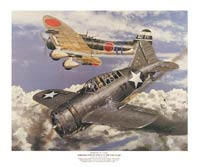
Brewster F2A-3 Buffalo
Tony Weddel. The only combat action involving Buffalos (in U.S. hands) was at
the Battle of Midway, where the Marine pilots of VMF-221 flew from the island's
airbase and intercepted an incoming Japanese aerial strike. Several Val
dive-bombers fell to the Buffalo's guns, but Zeros quickly jumped the Buffalos,
most of which were shot down in the ensuing battle. Buffaloes were then
withdrawn from front line duties and never used by U.S. forces in combat again.
23"x 19" print.
|
Simpson Harbor
Michael Hagel. On November 2, 1942, the Fifth Air Force attacked Rabaul, led by
Major John Henebry of the Third Attack Group. Here, Henebry's B-25, Notre Dame
de Victoire, pulls away from the cruiser Haguro after bombing a freighter
nearby. Damaged by the cruiser, Henebry was then attacked by Zeros forcing him
to make a water landing. Limited edition print measures 31"x 23" and is signed
and numbered by the artist and Major Henebry. |
|
Engaging the Enemy
William Phillips. Following the famous April 18, 1942, Doolittle Raid on Japan,
B-25 Mitchell #10 keeps the enemy at bay as it crosses the hostile skies of
Japan en route to China.
This 23"x 23", limited edition, numbered print is signed by the artist and by
four Doolittle Raid flight crew: Col. Richard Cole (Jimmy Doolittle's
co-pilot!), Maj. Edward Saylor, Maj. Thomas Griffin and S/Sgt. David Thatcher.
It even includes printed remarques of a Mitsubishi Zero and Crew #10's B-25
Mitchell near the Raiders' signing area! |
Bent Wing Sonata
Rick Herter. Protecting B-24 Liberators returning from a bomb run, an F4U
Corsair from VF-17, the "Jolly Rogers," races past a Japanese Zero - whose pilot
is bailing out - it just shot out of the sky over the South Pacific. 23"x 25"
limited edition print is signed and numbered by the artist. |
A6M Zero Shirts All Sizes
|





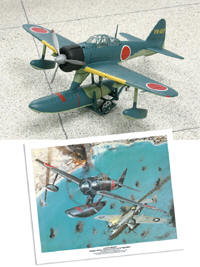
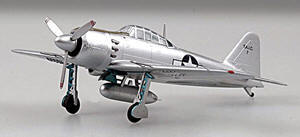 Mitsubishi
A6M5b
Mitsubishi
A6M5b 